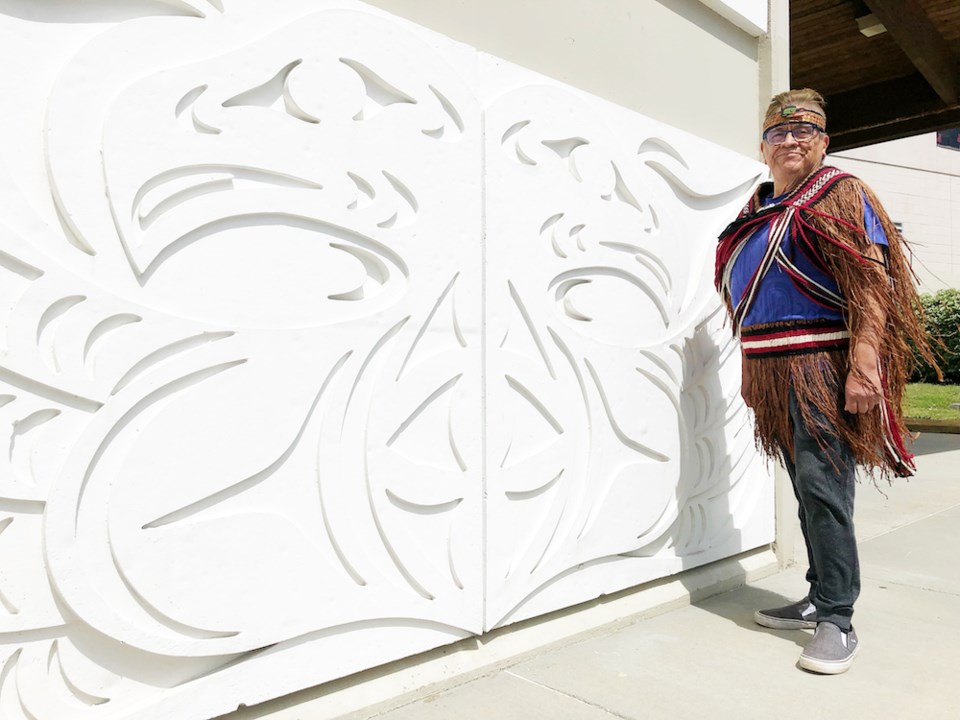You might find him dancing in traditional shíshálh regalia as lead singer of the tl’ikwem Dance Group. Perhaps he’s drumming and sharing one of his original songs about a sasquatch or a mountain goat. Or he could be at a loom, demonstrating basic weaving techniques. Maybe he’s teaching words and phrases from the shashíshálhem language, a Coast Salish dialect, to eager children at Kinnickinnick Elementary School. Or possibly, he’s offering a welcoming song as part of a land acknowledgements ceremony.
Whether he’s performing in the shíshálh long house or on the Lower Mainland, attending a language conference, or participating in a workshop on the U.S. west coast, the shíshálh Nation’s cultural ambassador kway?imin Andy Johnson is immersed in sharing his people’s identity and culture. (His ancestral name kway?imin, which he received from his late grandmother yetaxwelet Cecile August, means “the first light of the sun.”)
“Our language and songs are our identity as shíshálh people,” says the born-and-raised Sunshine Coast resident. Today, only one or two elders remain who speak the shashíshálhem language fluently, he adds. kway?imin says he learned a lot of his traditional language as a child spending summers with his grandmother yetaxwelet, who spoke it fluently. For instance, as they dug for clams, crabbed, found sea onions at tsúlich (Porpoise Bay) and picked berries, she would teach him the words for different berries and aspects of sea life.
“I didn’t always remember,” says kway?imin, “but she would repeat these words to me. The years went by, my Gramma would say these words to me again, and I would say, ‘Gran, you told me these words every time we went out.’ And she would say, ‘I am saying these words to you so you will learn them.’ Today, kway?imin says he’s not fluent in shashíshálhem but can say phrases and understand what elders are saying.
kway?imin is a member of the shíshálh Nation’s four-person language team, recommended in this role by an elder who said he had a natural way of pronouncing the language. He began as a language assistant in 2004 and in the following year, received training in hands-on teaching methods in Chase, BC. His first young students were at the mémmíman daycare facility, operated by the shíshálh Nation. “I loved working with the little ones because they are little sponges that repeat everything you say.” Since 2004, he has taught shashíshálhem at Kinnickinnick, Chatelech High School and Capilano University.
Recently, kway?imin has provided cultural content and shared traditional territorial names in a summer program with youth ages six through 12. He says, “With little kids, sometimes you think they’re not listening but they are.” He has also worked with tech-savvy youth leaders, and a language app is in the works, to be shared on FirstVoices.ca , a site that promotes the language, oral culture and linguistic history of Indigenous communities. “I tell youth: ‘One day, you’re going to be asked to speak about our identity as shíshálh people.’”
When asked what he’d most like non-Indigenous people to know about his people and culture, kway?imin replies: “The [2011 Sechelt] dictionary and our creation story, how we came to be.”
kway?imin listened to elders recording words, phrases and local place names for the 2011 release of the Sechelt Dictionary, which includes shashíshálhem-to-English and English-to-shashíshálhem translations. Work on this 1,005- page tome, produced by the shíshálh Nation and linguist Ronald C. Beaumont, began in the mid-1970s. More than 30 elders, including kway?imin’s grandmother, provided information, representing the last generations of speakers to learn shashíshálhem as their first language. (Copies are available at local libraries and for sale at the tems swiya museum in ch’atlich (Sechelt).)
During a photo shoot, kway?imin reveals that he wove his regalia’s apron and cape, made from yellow cedar that was first shredded and pounded by a member of the Skwxwú7mesh Úxwumixw (Squamish Nation). He started learning traditional weaving techniques in 2005, taught by his “dear relatives” Janice George and Buddy Joseph of the Skwxwú7mesh Úxwumixw.
Since then, kway?imin has hosted workshops on how to weave quarter bags, ceremonial sashes, shawls, tunics, wall hangings and memorial blankets. He helped to weave 15 sashes and shawls for the 2022 grade seven graduation class at Kinnickinnick. In 2019, he created two speaker-style sashes, worn over the shoulder like a ceremonial blanket, for the Weaving Reconciliation project, part of the syiyaya Reconciliation Movement for all peoples living within the shíshálh homelands. This joint initiative between Indigenous and non-Indigenous residents of the Sunshine Coast is a local response to the Truth and Reconciliation calls to action, inspired by and dedicated to the survivors of residential schools, including day scholars.
(kway?imin calls himself “just a survivor,” son of fisherman Andy Sr. and his late mother Stella Johnson, who worked as a teacher, at canneries up north and as a summer berry-picker in Bainbridge Island, Wash. She was a student at St. Augustine’s Indian Residential School in ch’átlích (Sechelt).)
The reconciliation sashes, woven in Coast Salish colours (black, red and white), are to honour all residential school survivors, kway?imin says, and their colours hold special significance, he explains. Black represents the dark times faced by all survivors while the red and white symbolize how shíshálh people are coming to the light and on a healing journey through reconciliation. In his artist statement, he wrote: “The sashes will be for all the survivors to be able to speak and share their stories, to be able to heal in a good way.



